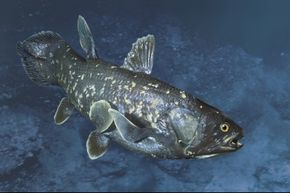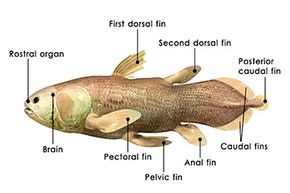Sixty-five million years ago, when dinosaurs roamed the earth, carnivorous fish that could stretch up to 6.5 feet (2 meters) long and tipped the scales at about 200 pounds (91 kilograms) filled the seas. These mysterious creatures were called coelacanths (SEEL-uh-kanths), and there were 90 species of its kind. Their craniums contained a mere speck of brain matter — the brain occupied only 1.5 percent of the cranial space and the other 98.5 percent was fat [sources: National Geographic, Smithsonian].
Everyone assumed coelacanths went the way of the dinosaurs and faded into extinction. But in 1938, one was discovered in the waters off of Africa's east coast. A second species of coelacanth was found in 1997 in Indonesia. Scientists speculate the two groups were separated from each other for several million years [source: Smithsonian].
Advertisement
It's difficult to know just how many coelacanths are out there today. For one thing, they can live as deep as 2,300 feet (700 meters) below the ocean's surface. Yet scientists believe there are no more than 1,000 of the Indonesian-based species alive today and few of the African coelacanth. Both groups are on the endangered species list [sources: National Geographic, Smithsonian].
That means you won't be able to nosh on one anytime soon (in case you were wondering how a prehistoric fish tastes). But that's a good thing, because they supposedly taste quite nasty. Further, dining on coelacanth flesh can actually make you sick, thanks to its copious amounts of oil, urea (ick!) and wax esters, to name but a few of its repulsive features [source: Bates]. They've also got slimy skin and scales that ooze mucus. Bet you're not so hungry for a taste of prehistoric fish anymore.
Advertisement






